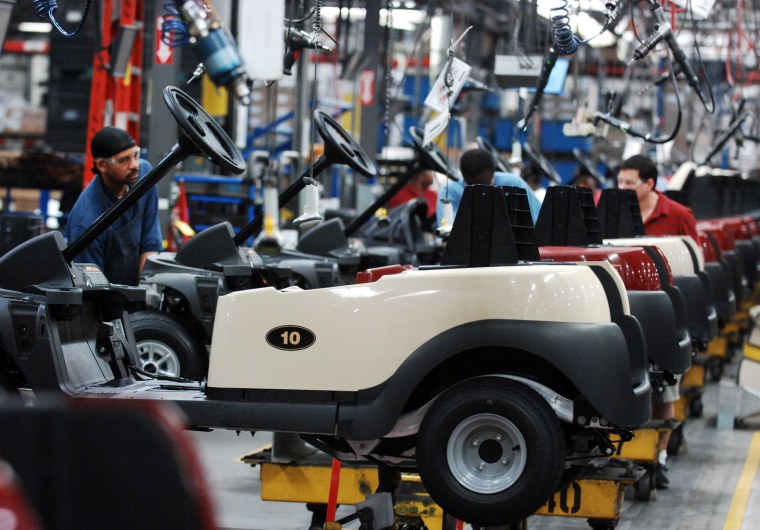Corporate America is back.
Companies that do everything from making appliances to selling cruises are reporting strong first-quarter profits — not because of the layoffs many of them used to dress up last year's earnings reports but because people are spending more.
The turnaround has yet to produce a dramatic increase in hiring, which isn't expected until 2011 or later. But it provides emphatic new evidence that the economy has moved past the crisis and should continue to strengthen.
"We're out of the woods for good," says Joseph LaVorgna, chief U.S. economist at Deutsche Bank. "This is not just an arithmetic story. It's a story of legitimate growth."
Companies in the Standard & Poor's 500 index have reported 76 percent higher operating earnings than a year ago — on pace to be the biggest year-over-year increase ever, according to S&P analyst Howard Silverblatt. Nearly half the companies in the index have reported earnings so far.
One reason for the gains is simply that the economy in early 2009 was at the depth of the worst recession in generations, but consumer spending is clearly making a comeback.
After a year and a half of hunkering down, people are buying expensive items such as electronics and furniture and dining out more, even though an unemployment rate of 9.7 percent clouds the recovery and the housing market is still hurting.
"They've saved some money, they've paid down debt, and at a certain point you just get bored of eating frozen pizza and watching cable TV on a Saturday night," says Barry Ritholtz, head of the financial research firm FusionIQ.
Consumers opening wallets
Consumer spending has risen for five straight months, retail sales for four, and restaurant sales surged this spring after being stagnant since 2008. Profits from those sales reflect a healthier economy, as opposed to the drastic cost-cutting that helped companies improve their bottom lines in recent quarters.
Among the latest winners, Ford Motor Co. did an about-face from a year ago in reporting a $2.1 billion profit on 15 percent higher revenue; it plans to boost production. Caterpillar Inc. also reversed a loss from a year ago and said demand for its construction and mining equipment is surging.
Royal Caribbean Cruises Ltd. returned to a first-quarter profit as more travelers vacationed on its ships and spent additional money on board. UPS Inc. posted a 33 percent profit increase; it said tech firms are shipping more products and other industries are restocking inventories.
A parade of other Fortune 500 corporations also have boosted their full-year profit forecasts this month. This week alone, the list includes DuPont Co., Estee Lauder Cos. and Whirlpool Corp.
Exports have played a key role. Caterpillar enjoyed especially strong orders for its heavy equipment in developing countries, and Deere Inc. also is selling more internationally. But domestic demand also has been strong.
"What we have now is rising exports and imports," says Richard Hoey, chief economist for the Dreyfus Corp.
Big manufacturers such as Whirlpool, the world's largest appliance maker, are among those faring the best.
"That's a function of consumers having cut back for so long and now saying, 'OK, I need a dishwasher' or the couch is broken or whatever, and going out and finding a lot of stuff on sale," says Ritholtz, who also writes the popular financial blog "The Big Picture."
Signs of recovery
Technology companies, too, are ramping up production. Intel Corp.'s sales climbed 44 percent in the first quarter.
And makers of luxury goods are benefiting from a release of pent-up demand for such items as jewelry, watches and high-end furnishings.
Economists say a jump in sales of consumer goods is typical in a recovering economy. Still, some are mystified by what Scott Hoyt of Moody's Economy.com described as surprising strength in consumer spending, given that the employment picture remains bleak for the near future.
Many people may be more inclined to spend after paying down debt or just holding onto their cash. Household debt has declined by a whopping $600 billion since the fall of 2008, according to Economy.com.
Consumers are saving less, too. After hovering near 5 percent for much of last year, the savings rate dropped to 3.1 percent in February. That's the lowest rate since October 2008, according to the Bureau of Economic Analysis.
The bull market is a signal of increasing confidence to spend, and may have provided some of the funds to do it.
After reaching a bottom in March 2009, the stock market rallied for three months as investors realized the economy wouldn't sink into a depression. Then after stalling for several weeks, the S&P 500 has tacked on another 35 percent since last July.
The growth in both consumer spending and the stock market may not continue at this pace. But all the executives who are raising their companies' earnings and sales outlooks clearly believe the first quarter was no mirage.
